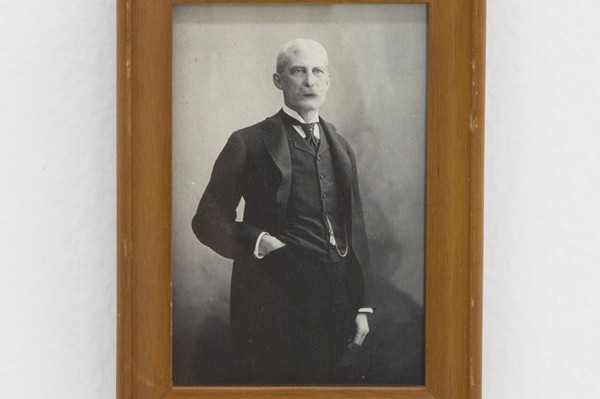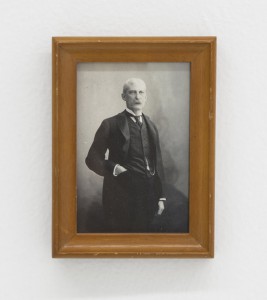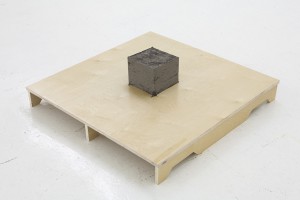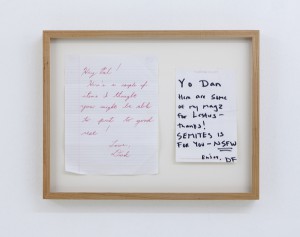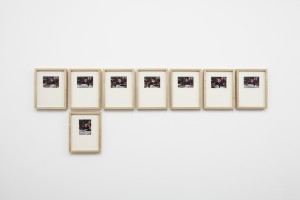2.12.13 Walking through “The Umpire” with Daniel Milewski by Meaghan Kent
Daniel Milewski’s current exhibition at Gallery Diet in Miami is a hybrid of objects that, at first glance, seem somewhat disparate in its minimal arrangement. A loose weaving of photographs, notes, t-shirts, a baseball, and other found objects are combined to investigate the banal, to tease out the overlooked. Daniel Milewski walked Carolyn Salas and me through the exhibition beginning with an appropriated image of the historical Florida developer Henry Morrison Flagler.
Daniel Milewski: It’s a fairly well known image that I intended for people to overlook and possibly miss. It mimics the same way you draw a moustache on. The scale of it allows you to not see it in such a grand manner, and you can walk right past it.
Carolyn Salas: What I like about it is that his lips are kind of off.
DM: It’s about memory and how you can forget or remember different parts of history. How you might notice something is either normal or perverse. He is such a notable local figure. It might have been easier to choose someone more known like Teddy Roosevelt, but he is just knowable enough for people that come here.
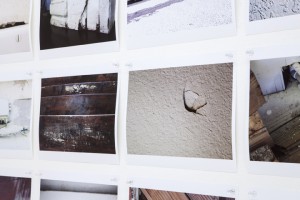
Daniel Milewski, Everything Wrong with the House, 2012, 45 digital c-prints, acrylic push pins, 52.5 x 78in
Meaghan Kent: There is a sense of locality with some of the pieces in the show, for instance your home documentation in “Everything Wrong with the House.” Are you from here?
DM: I’m originally from Massachusetts and lived here for 7 years. A lot of the show deals with memory or perception. Both series, “Everything Wrong with the House” and “Flagler,” are talking about cartography in a similar way.
They had photographed our house for the Style section of The New York Times. But we live in a funny neighborhood that is somewhat ghettoized. We renovated for several years so it does look nice but I thought it was interesting and kind of funny that The Times had photographed it in a wonderful, perfect kind of way when there are imperfections and things that needed to be fixed. So this series was put together or mapped together, initially for myself, for my own neurosis. And these images can be endless; you could remove a piece of plywood and find something else. No matter how much you think you are representing something there is always an unknown factor. Even in something as mundane as fractures in a wall.
MK: And this is what you discussed in the press release the everyday objects, everyday living. The banal.
DM: Yes. Things become grand in banal objects. I was talking with someone the other day about Olafur Eliasson’s photographic vignettes of landscapes and riverbeds and how his work is trying to capture something that is difficult to visualize, something grandiose in a smaller space. It is a similar idea in my work. This is what I built up, collect, and even obsess over.
Also, perceptions are different: to me, they are imperfections in my house; to someone else, there is abstract formalism. I am certainly making a formal decision with the camera, framing something that I can’t readily frame with my eye.
CS: Does “Gram” also relate to the home and labor?
DM: It didn’t necessarily come from the apartment but mostly from the studio. I have an old barbecue and I would light small fires and burn materials over the course of several months.
It is reminiscent of Japanese gardens and how there are different stages of meditation. There is meditation during the process of forming it, maintaining it, and once it is perfected. If a strong wind came in the structure would be compromised, it would need to need to be taken apart and reformed. There are imperfections too that could get better over time.
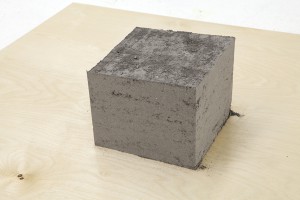 The palette represents some sort of portability and defines parameters. I am also interested in the idea of storytelling (around campfires). “Gram” alludes to many different things. “Gram” can be a unit of measurement, a grandmother, Gram Parsons. Do you know Gram Parsons? He is a country/rock singer who died near Joshua Tree National Park and when he died, they stole his body and burned it at Joshua Tree. Of course it didn’t work because they were all messed up on drugs.
The palette represents some sort of portability and defines parameters. I am also interested in the idea of storytelling (around campfires). “Gram” alludes to many different things. “Gram” can be a unit of measurement, a grandmother, Gram Parsons. Do you know Gram Parsons? He is a country/rock singer who died near Joshua Tree National Park and when he died, they stole his body and burned it at Joshua Tree. Of course it didn’t work because they were all messed up on drugs.
CS: He wanted his ashes to be left there.
DM: I was interested in linking it with this heavy rock and roll myth. We were there recently (with Nina Johnson) and there was a makeshift shrine. I like the idea of this object moving from place to place. I also like that there are direct stories or links that you can go to or not, your brain can fire into different directions.
MK: The piece includes a note from your father?
DM: Yes, we’ve been talking about how I thought about the show and how I sometimes use personal objects. I’ve almost thrown away these two notes a few times and for some reason I kept them and they are now included in this show. Both notes are almost identical in what they are trying to get across. One is from my dad, the other from a friend with the abbreviated “Not Safe For Work.”
CS: I was trying to figure out NSFW.
DM: Yes, it is a fairly common abbreviation and often used as a warning of sexual content. So there is a kind of interesting interaction between the two including the choice of paper itself: the notebook paper from my dad and the Barbara Gladstone stationary with Sharpie from a friend.
MK: Also, they are notes to accompany specific objects that we can’t see. Unknown objects.
DM: They are about communication and are not necessarily a thing on their own until now.
CS: It makes me think of the feature on 60 minutes of this man who was caught stealing official documents from the White House, how he had a trench coat designed to hold files. Would we have noticed them missing and when? It makes you consider how history is created over time.
DM: And that’s part of a bigger idea, like the myth of the rock star.
MK: I remember our studio visit last year and looking at your work and interpreting some of your exhibitions as a kind of group show. Where the pieces seem so different. At a first glance the connections aren’t readily clear, which is interesting to think about in context to finding these different meanings. And I think it could be connected even to the title of this exhibition, “The Umpire”, where you can make the decisions on how these works can and cannot relate.
DM: Yes, I like making works that look very different, yet in the context of a show are allowed to relate to each other.
DM: We were traveling and went to dinner with this little boy (a family member) and bought this top along the way. I like using my camera phone and the digital shot rather than an over produced image so that, like the notes, they are something that I can arrange and re-arrange.
He’s playing with this at dinner. He’s at that age, 7 or 8, before becoming an ornery teenager while at the same time having complex thoughts. So he is looking at this top: a children’s toy that has all of these properties of the universe. Laws of Physics are happening. And in these moments of me taking the photos he is at times enthralled but also completely distracted. I like the enormity of those moments. I think we all do that.
“The Umpire” is currently on view at Gallery Diet through Saturday, February 16.
Tags: Journal